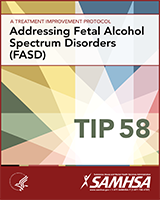NCBI Bookshelf. A service of the National Library of Medicine, National Institutes of Health.
Center for Substance Abuse Prevention (US). Addressing Fetal Alcohol Spectrum Disorders (FASD). Rockville (MD): Substance Abuse and Mental Health Services Administration (US); 2014. (Treatment Improvement Protocol (TIP) Series, No. 58.)
This TIP is divided into three parts:
- Addressing Fetal Alcohol Spectrum Disorders, Part 1: Background and Clinical Strategies for FASD Prevention and Intervention
- Addressing Fetal Alcohol Spectrum Disorders, Part 2: Administrator's Guide to Implementing FASD Prevention and Intervention
- Addressing Fetal Alcohol Spectrum Disorders, Part 3: Literature Review
Parts 1 and 2 are presented in this publication; Part 3 is available only online, at http://store.samhsa.gov/home. Each part is described below.
Part 1 of the TIP is for behavioral health providers and consists of three chapters:
- Chapter 1 discusses approaches to preventing FASD; that is, assisting women who are in treatment settings and are pregnant or may become pregnant to remain abstinent from alcohol. In providing these guidelines, this TIP adopts the Institute of Medicine (IOM) model for prevention, which sees prevention as a step along a continuum that also incorpo rates treatment and maintenance.
- Chapter 2 discusses methods for identifying individuals in treatment who have or may have an FASD, referring them for diagnosis where possible, and providing appropriate interventions to meet their needs.
- Chapter 3 provides clinical vignettes designed to realistically portray the provider–client interactions that might take place when providing FASD prevention or interventions.
Part 2 is an implementation guide for program administrators and consists of two chapters.
- Chapter 1 lays out the rationale for the approach taken in chapter 2 and will help readers understand how administrators can provide support for programs and counselors as they address FASD. It is hoped that this knowledge will enhance the ability of treatment programs to address FASD concurrently with other behavioral health needs; addiction, mental health issues, etc.
Part 3 of this TIP is a literature review on the topic of FASD and is available for use by clinical supervisors, interested counselors, and administrators. Part 3 includes literature that addresses both clinical and administrative concerns. To facilitate ongoing updates, the literature review will only be available online at http://store.samhsa.gov/home.
- How This TIP Is Organized - Addressing Fetal Alcohol Spectrum Disorders (FASD)How This TIP Is Organized - Addressing Fetal Alcohol Spectrum Disorders (FASD)
- MAG: Candidatus Methanomethylicia archaeon isolate DRTY-7_201803_bins_67, whole ...MAG: Candidatus Methanomethylicia archaeon isolate DRTY-7_201803_bins_67, whole genome shotgun sequencing projectgi|2724474331|gb|JAVZRH000000000.1| H010000000Nucleotide
- PREDICTED: Mus musculus transforming, acidic coiled-coil containing protein 2 (T...PREDICTED: Mus musculus transforming, acidic coiled-coil containing protein 2 (Tacc2), transcript variant X32, mRNAgi|1907183026|ref|XM_036153293.1|Nucleotide
- Bacillus sp. DB14361 16S ribosomal RNA gene, partial sequenceBacillus sp. DB14361 16S ribosomal RNA gene, partial sequencegi|821350696|gb|KP670229.1|Nucleotide
- Praon volucre isolate def2 cytochrome c oxidase subunit I (COX1) gene, partial c...Praon volucre isolate def2 cytochrome c oxidase subunit I (COX1) gene, partial cds; mitochondrialgi|2246021279|gb|ON623676.1|Nucleotide
Your browsing activity is empty.
Activity recording is turned off.
See more...
